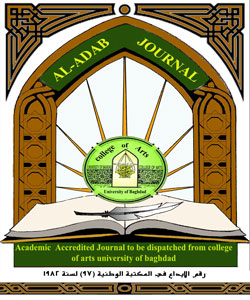The Development of Technical Treatments for Flashback in Cinematographic Mediator
DOI:
https://doi.org/10.31973/aj.v0i133.912Keywords:
Technical Treatment, Cinema, Television, Scene, Shot, FlashbackAbstract
The development cannot abandon technical-artistic creativity, and each art has its own language and its working tools by which the artist can communicate his ideas, so he can be creative in forming and formulating them within artistic treatments that contribute to enriching the visual image and the subject expressed, and it is from this idea that the research sheds light on the development Technical treatments for scenes of flashback in the cinematographic environment, which enter among the various technical treatments employed by the director, and contribute to creating appropriate and expressive influences and inspirations within the course of the flashback scene to include time indications related to the structure of time in the cinematographic work, and after the digital world entering the film and television milieu, this milieu have benefited from employing new techniques to scenes associated with flashback goals, which contributed to the diversification process at work and address various technical treatments on the level of form in the presentation of the flashback scene.
Downloads
References
2. Gibran Masoud, The Pioneering Lexicon, 7th edition, Dar Al-Alam For Millions, Beirut, Lebanon, 1992.
3. Gennett, Gerard, The Story of the Story, T., Mu'tasim, The General Authority of Al-Amiriya Printing Press, 1997.
4. Al-Razi, Muhammad bin Abi Bakr, Mukhtar Al-Sahah, Dar Al-Risala, Kuwait, 1982.
5. Ralph Stevitson, Jean Dupree, Cinema, Art, T, Khaled Haddad, Damascus, Publications of the Ministry of Culture - Public Institution Cinema, 1993.
6. Rene Willik, Critical Concepts The Concept of Evolution in Literary History, T, Muhammad Asfour, The World of Knowledge, 1990.
7. Zaki Al-Jaber, “The Mechanism for the Development of Communication Technology,” Arab Broadcasting Magazine (Union of Arab States Broadcasting, 2000).
8. Salman, Abdel Basset, Photojournalism - Television, Photography, Cairo Cinema, Cultural Publishing House, 2010.
9. Swensen, Arthur, Writer for Television, Ter: Ismail Arslan, Cairo, Egyptian House of Authoring and Translation, 1966.
10. Sabry, Harmony Sabry, Reflections of Western Thought in Directive Treatments of the Arabic TV Song, MA Thesis M.G. (Baghdad University, College of Fine Arts, 2004).
11. Saliba, Jamil, The Philosophical Lexicon, 1st Floor, Beirut Lebanese Book House, 1971.
12. Alloush, Saeed, Glossary of Contemporary Literary Terms, Casablanca, University Library.
13. Omar, Ahmad Mukhtar, A Dictionary of Contemporary Arabic Language, Volume 3, Cairo, The World of Books, 2008.
14. Al-Anani, Hanan Abdel Hamid, Educational Psychology, 3rd floor, Al-Safa House for Publishing, Printing and Distribution.
15. Gaskell, Making Your Own Hollywood Movies, Beirut, Arab Science House - Publishers, I, 2007.
16. Muhammad Samir Muhammad, The Aesthetic and Dramatic Enrichment of Digital Color Correction Programs in Cinematography, Master Thesis, University of Baghdad, G.M., 2016.
17. Morsi, Ahmed Kamel, Magdi Wahba, Dictionary of Cinematic Art, The Egyptian General Book Authority, Cairo, 1973.
18. Almohandis, (Hussein Helmy), Screen Drama, Part 1, Egypt, The Egyptian General Authority for Books, 1989.
19. Howard Lawson, John Howard Lawson, Creative Practical Cinema, T, Ali Ziauddin, Baghdad, House of General Cultural Affairs, 2002.
20. Youssef, Aqeel Mahdi, Attractive Motion Picture, Tripoli United New Book House, 2000, p. 13.
21. Websters, New World Dictionarw of American Language, College Education, The World Publishi, Seventh, 1960.
Downloads
Published
Issue
Section
License
Copyright and Licensing:
For all articles published in Al-Adab journal, copyright is retained by the authors. Articles are licensed under an open access Creative Commons CC BY 4.0 license, meaning that anyone may download and read the paper for free. In addition, the article may be reused and quoted provided that the original published version is cited. These conditions allow for maximum use and exposure of the work.
Reproducing Published Material from other Publishers: It is absolutely essential that authors obtain permission to reproduce any published material (figures, schemes, tables or any extract of a text) which does not fall into the public domain, or for which they do not hold the copyright. Permission should be requested by the authors from the copyrightholder (usually the Publisher, please refer to the imprint of the individual publications to identify the copyrightholder).
Permission is required for: Your own works published by other Publishers and for which you did not retain copyright.
Substantial extracts from anyones' works or a series of works.
Use of Tables, Graphs, Charts, Schemes and Artworks if they are unaltered or slightly modified.
Photographs for which you do not hold copyright.
Permission is not required for: Reconstruction of your own table with data already published elsewhere. Please notice that in this case you must cite the source of the data in the form of either "Data from..." or "Adapted from...".
Reasonably short quotes are considered fair use and therefore do not require permission.
Graphs, Charts, Schemes and Artworks that are completely redrawn by the authors and significantly changed beyond recognition do not require permission.
Obtaining Permission
In order to avoid unnecessary delays in the publication process, you should start obtaining permissions as early as possible. If in any doubt about the copyright, apply for permission. Al-Adab Journal cannot publish material from other publications without permission.
The copyright holder may give you instructions on the form of acknowledgement to be followed; otherwise follow the style: "Reproduced with permission from [author], [book/journal title]; published by [publisher], [year].' at the end of the caption of the Table, Figure or Scheme.












